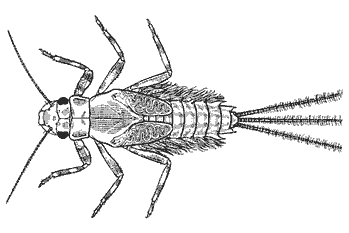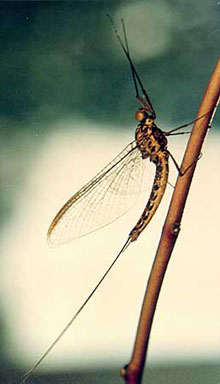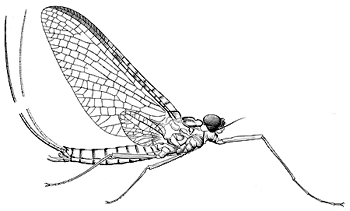|
Ephemeroptera:
mayflies
Characteristics
Mayflies
are small to medium sized insects with an average wingspan up to
15 millimetres. As their name suggests, mayflies have only a short
adult life ranging from a few hours up to a day or two depending
on the species. Mayflies can be recognised by the following characteristics:
|
Atalophlebia
species (LEPTOPHLEBIIDAE)
|
|
- Hind
wings much smaller than the forewings
|
Mayfly nymphs
are aquatic and have a similar body shape to the adults but lack
wings. The nymphs
have gills along the sides of their abdomen,
which look similar to fine leaves.

Atalophlebia species (LEPTOPHLEBIIDAE)
|
LEPTOPHLEBIIDAE
is the dominant family of mayflies in Australia. The species are
adapted to many habitats ranging from warm standing waters and coastal
waterholes to the melted snow of subalpine areas. Atalophlebia
species contains all the common large mayflies, most with a wingspan
of up to 25 millimetres. The males of many species have 2 very long,
white tipped cerci
which can be up to 35 millimetres in length. Many species occur
in slow flowing streams and lakes, while others can be found in
billabongs of dry inland Australia or subalpine streams. The larvae
of this species can be distinguished by their paired leaf-like gills
along the sides of the abdomen.
|

Coloburiscoides species
|
Life Cycle
Mating
occurs during flight and large swarms of mayflies gather close to
the fresh water habitats they prefer. Eggs are laid on the water
surface of lakes and streams where they sink, scattering along the
substrate and amongst aquatic plants and debris. Upon hatching the
nymphs
live on the bottom, sheltering under stones or in the substrate.
Development can take from several months up to a year and can involve
from 20 to 50 moults
depending on the species.
Feeding
Adult mayflies do not feed. The nymphs
feed on aquatic plants and other associated organisms by scraping
algae and detritus from underwater stones and vegetation. Some species
are also known to be predators.
Habitat
Adult mayflies occur everywhere in Australia but are always found
near freshwater environments. The larvae are aquatic and each species
has preferences for a different type of habitat, which is influenced
by factors such as water temperature, flow rate, chemical composition
and light. The majority of Australian mayflies prefer cooler habitats
with clear flowing water and are therefore more abundant in the
mountain streams of the country.
|



